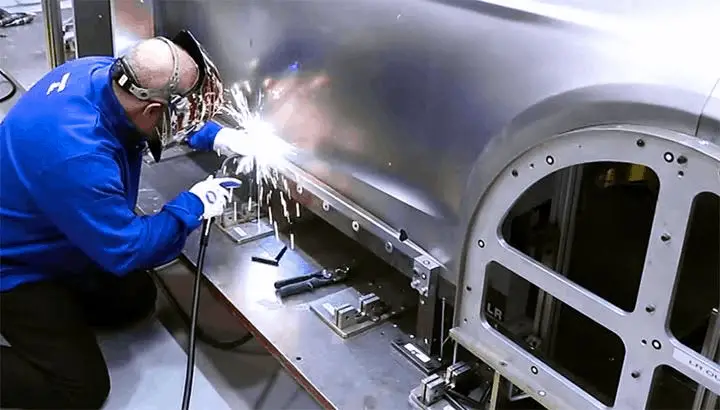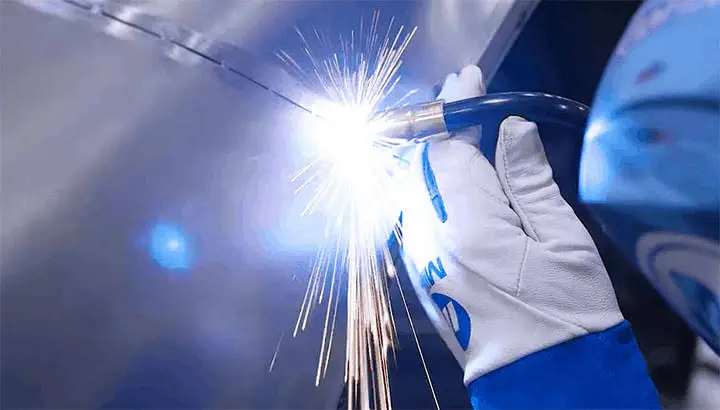Some of the problems with thin metal include burn through and excessive warping. You also have to avoid excessive heat affected areas while still ensuring the weld is strong enough. Most of the thin gauge sheet metal are made from steel, stainless steel, aluminum or galvanized. It is imperative you consider the shielding gas, welding process, and electrode before welding 20-gauge sheet metals.
In the US sheet metal is designated through the gauge, the larger the number the thinner the metal. Typically, the gauges run from 7 to 30 gauge. Sheet metal has usage in sectors like making automobiles, airplane wings and fuselages, roofing and medicinal tables.
MIG Welding for thin metal
MIG is one of the best ways to weld 20-gauge sheet metal. MIG welding is one of the simplest to use for welding. It is an arc welding process that where you feed a solid wire electrode through a welding gun. Metal inert gas is then used to protect the weld from contaminants. The variety of metals that can be welded through the MIG process varies from ½ inches to 24-gauge.
If you are thinking of pulsed GMAW then it is advised to use a more argon based argon gas content. In this case, 95% argon and 5% carbon dioxide. The benefit of using pulsed GMAW is that it generates low spatter, one gets better control of the arc and offers a wider range of operating parameters. The downside is that equipment for GMAW is expensive.
When it comes to wire selection for the MIG the rule of the thump is to avoid using filler metal that is thicker than the base metal. Most of the light gauge sheet metal work will require the use of .023- or .24- inch while if you have a sheet metal having a gauge of more than 18-gauge then a .030-inch wire would be the most ideal. A ER70S-6 wire would be most ideal for welding mild steel. For the inert gas, aim at having more argon to carbon dioxide – 75% argon to 25% carbon dioxide. Argon helps reduce cases of spatter as it carries less heat.
If you are going to be welding 304 stainless steel the such for wires like ER308L, ER308, or ER308LSI; for the 316L stainless steel use 316L wire. The gases will change for this and you should use 90% helium, 8% argon and 2% carbon dioxide. Lastly, do not try to use flux cored wires for thin metal sheets as they pass more heat to the base metal.
Flux-cored arc welding (FCAW)

This is another option for welding a 20-gauge metal sheet but does not work as well as the MIG. Problems arise with the fact that you have a protective slag that needs to be gotten rid of after welding. It also has more smoke levels and lower deposition rates than the GNAW. You can use small diameter electrode to lower the heat input. The difference between the two is for the GNAW you have most of the heat been generated at the base metal while for the FCAW self-shielded flux wire. This flux wire enables one to do job site welding. The wires in FCAW are direct-current electrode negative.
For you first option use the ceriated tungsten followed by the thoriated tungsten. If you are welding thin sheets ignore the 1/8 inch tungsten electrode. When welding thin metal sheets you should try to avoid burn-through as much as possible. This means going with smaller electrodes that work well at lower heat settings. For the filler material you can either go with ER70S-2 and silicon bronze. The benefit of this is that it has heat reduction properties due to its soft nature. When the filler is close to the base metal it won’t overheat and this gives it a chance to join with the metal.
Whatever filler material you use, it should be thinner than the base metal. You can also use an inverted-based power source for working on a thin aluminum. Aluminum alloys for sheet fabrication are 5052 or 3003 while the filler metals would be 4943 or 4043. For 5052 try 5356 filler metal.
Gas tungsten arc welding (GTAW)
You can also use the GTAW for high quality and low volume welding applications. GTAW has the benefit of producing no spatter, high quality welds and best fusion. This method of welding is requires some technical skill and is not as simple as the MIG one. For the best results with little welding distortions go for tungsten electrode with a diameter of 3/32 inches. For the shielding gas use 100% argon.
Welding techniques for thin metal
To avoid burn through of the thin metal you will need to be very careful not to whip or weave the torch. When welding move in a straight line and use the push technique of the MIG gun. To prevent blowout move the wire to cooler edges of the base metal.
- Skip welding
Thin metal sheets have higher chances of getting warped due to the uneven distribution of heat. In skip welding one is able to make stitch or intermittent welds hence distribute the heat evenly and reduce distortions.
- Backing bars
These bars help in reducing distortions by dissipating heat faster than cooling from the atmosphere. The bars are mostly aluminum or copper bars and you place them on the heat affected areas.
- Fit up and joint design
The problem with welding very thin metals is that if you miss out on the joints for even a few inches then you expose your joints to burn-through. The solution is to be very meticulous when cutting so that you do not miss by an inch. Alternatively, redesign the joints so that they can withstand heat or use a plug weld.
Tips for ensuring good weld for thin metals

There some cases you will be forced to use shielded metal arc for welding joints. In this case you should use a low amperage, small diameter electrode. This allows you to maintain fast travel speed for flat and horizontal positions. It will require some practice but if you are considering welding in a vertical position then increase your welding amperage by 25%. Welding in vertical position is however, not ideal for thin metals. If you are going to be doing stainless steel metal sheets then we would suggest you go with the pulsed GNAW. If you prefer the SCT mode then change the inductance settings of the power source to weld puddle.
Right filler material
When it comes to the filler material the idea is to match it with the right base material. For stainless 316 use 316 filler, for stainless steel 304 use 308 filler metal, for carbon steel use 309 filler metal. Shielding gas is used to protect the weld from contaminants with the basic idea of having more argon in the mixture. If you are working on a stainless steel material using GNAW use a mixture of 98% argon and 2 carbon dioxide. You will also find welders getting into tri-mixes with gases like helium or nitrogen. The downside to tri-mixes is these gases are not cheap. If you go the FCAW way then aim at shielding gas mixtures of 100% carbon dioxide or a blend of 75% argon and 25% carbon dioxide.
If you are going to be working on some aluminum thin metals then it is imperative you do a pre weld joint preparation. Aluminum has a heavy oxide layer that tends to have a higher melting point than the underlying base metal. To your welding easier prepare the joint through grinding or wire brushing. You will also need a corresponding filler metal like the ER4043/ER4047 or ER5356. This should be matched to the base metal. For the best welding results using GMAW use a blend of 50% helium and 50% argon but since helium is a bit expensive go with 100% argon.
If you are doing galvanized welding then the procedure is almost similar to what we have described above with a slight difference. For one you have a zinc layer on the galvanized sheets that is a poor conductor. This leads to poor bead appearance and porosity. In this scenario you will need to change the welding gas combustion to consist of 75% argon and 25% carbon dioxide blend. You should also adjust your welding settings for slower travel speeds and use a slightly higher voltage. For the wire you can opt for a flux cored wire with small diameter like the dual shield type. This kind of wire has inner flux in it. This under heat offers shielding gas and a protective slag layer. Due to the methods of cleaning used you tend to have better weld quality and bead appearance.
Conclusion
Welding thin metal is not easy as you can easily make holes on the weld. MIG is the ideal method for welding a 20-gauge metal sheet. The process is fast and simple to use. The only downside is you cannot use it for outside welding as the wind can easily blow out your shielding gas.
